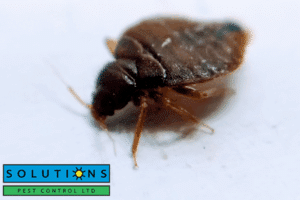Bed bugs are notorious for causing discomfort and distress in homes. They may be tiny, but their impact is significant, especially when they’re not spotted early. While many homeowners focus on detecting the pests themselves, it’s equally important to look for signs of bed bug droppings. These droppings are a key indicator of an infestation, and knowing where to look for them can help you take swift action before the problem worsens.
In this blog post, we’ll walk you through the common places where bed bug droppings are typically found in your home and explain how to identify these markings. By the end, you’ll be better prepared to spot these pests, seek effective bed bug treatment, and prevent further damage.
What Do Bed Bug Droppings Look Like?
Before you begin searching for droppings, it’s important to know what they look like. Bed bug droppings are often mistaken for other stains, but they have specific characteristics that make them easy to identify once you know what to look for.
Bed bug droppings are typically small, dark, and resemble tiny spots of ink or rust. They are often black or dark brown, and you may find them in clusters. These droppings are actually digested blood, meaning they are a sign that the bed bugs have been feeding. Since bed bugs often feed at night, their droppings may be found in areas where they hide during the day, such as cracks, crevices, or bedding.
If you’re asking what do bed bug droppings look like, you’ll notice that the stains may vary in size, but they are generally about the size of a pinpoint or slightly larger. Additionally, the droppings might appear wet at first but will dry and harden over time.
Common Places to Look for Bed Bug Droppings
When searching for bed bug droppings in your home, there are several key areas where you should focus your attention. These spots are typically where bed bugs hide and where they leave their droppings behind. Here’s where to start:
1. Bedding and Mattresses
The most common place to find bed bug droppings is on the bed. Check the seams, edges, and folds of your mattress and box spring. Bed bugs love to hide in the tiny crevices of the fabric and the corners where the mattress and box spring meet. You may also find droppings on your sheets or pillowcases, especially if the infestation is severe. Look closely for tiny, dark spots along the seams of the mattress and any hidden areas under the fabric.
2. Furniture and Upholstery
Bed bugs don’t limit themselves to the bed; they’ll also hide in upholstered furniture. Sofas, chairs, and armchairs are common targets for these pests. Look along the seams, under cushions, and in the folds of the upholstery. Bed bug droppings can often be found in these areas, as they like to hide where they are less disturbed during the day. Pay attention to crevices and the fabric folds, as these spots offer excellent hiding spaces.
3. Cracks and Crevices
Bed bugs are expert hiders, and cracks and crevices in walls, baseboards, and floors are prime spots for them to settle. Check behind picture frames, electrical outlets, light switch covers, and baseboards. Bed bugs can squeeze into the smallest of spaces, so be thorough when inspecting these areas. Droppings may accumulate in these tight spots, and you may also notice the presence of shed bed bug skins.
4. Behind and Under Furniture
If you suspect a bed bug infestation, don’t forget to inspect the back of furniture and any hidden areas under couches or dressers. Bed bugs can hide behind furniture where they are less likely to be disturbed. Look for droppings along the edges or underneath furniture, especially in areas that you may not frequently clean or check.
5. In and Around Electrical Appliances
Bed bugs are known to hide in unusual places, and electrical appliances are no exception. Bed bugs can squeeze into electrical outlets, light fixtures, and even behind or inside electronics. The dark, undisturbed spaces around appliances provide ideal conditions for these pests to thrive. Be sure to inspect these areas closely and look for any signs of droppings near outlets or cords.
6. Closets and Storage Spaces
Closets are another common hiding place for bed bugs. They often make their way into clothing and personal belongings stored in closets. Bed bug droppings are frequently found along the edges of shelves, in clothing, and inside storage bins. You may also notice small dark spots on your shoes or bags if they’ve been in close proximity to the infestation.

Why You Should Look for Bed Bug Droppings
Detecting bed bug droppings early is crucial for preventing an infestation from spreading. These droppings are a clear sign of bed bug activity, and finding them is often the first step in taking action. The presence of droppings, especially in large quantities, can indicate that the infestation is well-established and may require professional pest control assistance.
The longer you wait to address the issue, the more likely it is that bed bugs will spread to other areas of your home. By finding droppings early and acting quickly, you can prevent further damage to your home and belongings.
What to Do If You Find Bed Bug Droppings
If you find bed bug droppings in your home, it’s important to act quickly. Here’s what you should do:
1. Inspect Your Home Thoroughly
Start by performing a thorough inspection of your home, focusing on the areas mentioned above. Check your bed, furniture, and other potential hiding spots. Look for additional signs of bed bugs, such as blood stains, shed skins, and the bugs themselves. The more areas you inspect, the better you can assess the severity of the problem.
2. Contact a Professional Pest Control Service
If you find bed bug droppings or other signs of an infestation, it’s time to contact a professional pest control service. Bed bugs are notoriously difficult to eliminate on your own, and a pest control expert can provide effective treatments to get rid of them. In areas like West Vancouver, BC, where infestations can spread quickly, a pest control West Vancouver service is essential for addressing the problem thoroughly.
3. Follow Professional Advice
Once you’ve contacted a bed bug exterminator, be sure to follow their advice and recommendations for preventing future infestations. This may include additional inspections, cleaning tips, and recommendations for sealing cracks or gaps where bed bugs could enter.
About Solutions Pest Control
At Solutions Pest Control, we are dedicated to providing high-quality pest control West Vancouver BC services to help homeowners manage bed bug infestations and other pest problems. We understand the importance of protecting your home from unwanted pests, and our team of experts is equipped with the tools and knowledge to tackle any issue. Whether you’re dealing with bed bugs or other pests, we offer comprehensive services to ensure your home remains safe and comfortable


